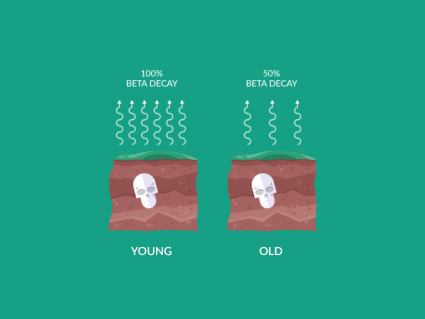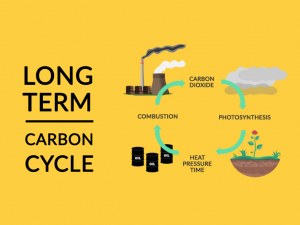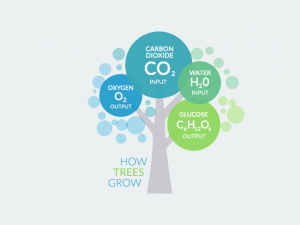What Is the Carbon Cycle? Photosynthesis, Decomposition, Respiration and Combustion

Carbon cycles from the atmosphere into plants and living things. For example, carbon is a pollutant in the atmosphere as carbon dioxide.
But it’s also the most important building block for all living things including glucose.
Over millions of years, carbon can get re-purposed into hydrocarbons. This is the long-term carbon cycle.
So, carbon takes up various forms: glucose in plants, carbon dioxide in the air, and hydrocarbons like coal.
But today, we’ll talk about the short-term carbon cycle that just takes days, months, or years for carbon to cycle through the environment.
1. Photosynthesis

Plants pull carbon dioxide out of the air through photosynthesis. Even though carbon dioxide makes up less than 1% of the atmosphere, it plays a major role in living things.
With CO2 and H2O in the atmosphere, photosynthesis produces sugars like glucose. This is the plant material that plants synthesize on their own.
If you have the right conditions, this process can repeat for centuries. Not only does photosynthesis pull carbon dioxide out of the atmosphere, but it fuels all living things as a source of energy.
2. Decomposition

By mostly using sunlight, water, and carbon dioxide, plants can grow. In turn, animals consume food for energy using O2 and giving off CO2. Alternatively, they die, decay, and decompose repeating for millions of years.
Decomposition is the process of breaking down plants. Over vast periods of time, layers of sediment build on each other. Because of the pressure and heat from within the Earth’s crust, it generates fossil fuels. Much of this happened during the Carboniferous Era.
For example, coal, oil, and natural gas (methane) are some of the common fossil fuels. Over the long term, the decomposition of dead matter generates these fossil fuel products.
Anaerobic decomposition involves bacteria breaking down organic matter such as glucose into CO2 and methane (CH4). The nutrient cycle recycles inorganic and organic material in the soil through the process of decomposition. Then, it goes back again through the same process again.
3. Respiration

You and I are both made of carbon. We consume plants. But we also breathe in the air, which has carbon in the form of carbon dioxide.
Animals rely on plants for food, energy, and oxygen. Our cells require oxygen to break down the food we consume through cellular respiration.
Once consumed, carbon dioxide is released into the atmosphere because of cell respiration. In turn, this CO2 produced from respiring cells can be used in photosynthesis again.
In other words, plants use solar energy to break apart that same carbon dioxide in the air. Through photosynthesis, it uses that same carbon for plant material in turn releasing oxygen again.
4. Combustion

Our cars use the energy released by burning fossil fuels. And carbon is also a pollutant as carbon dioxide.
We extract fossil fuels, combustion involves burning them to release energy. But a by-product of combustion is that it releases carbon dioxide back into the atmosphere. And too much CO2 increases the greenhouse effect.
Because we deplete our oil reserves by adding CO2 into the air daily, it affects the carbon cycle with an imbalance of oxygen and carbon. Carbon dioxide is one of the greenhouse gases contributing to climate change.
But there is a limit to how much fossil fuels we can extract. Over millions of years, phytoplankton resting on the ocean surface photosynthesizes and takes in CO2.
Using sunlight creates a molecule called glucose (C6H12O6) and sinks to the bottom of the ocean. Humans discovered these fossil fuels beneath the ocean. We started to drill the ancient plankton, which over millions of years ago, became the oil we use today.
Long-term carbon cycle summary

Today, you’ve learned how carbon cycles from the atmosphere and then into plants and living things. But the distinction between the short-term carbon cycle is that this cycle takes millions of years to come full circle.
Instead of carbon converting into sugars, carbon is re-purposed into fossil fuels like coal. When plants are buried and compacted over millions of years, they become hydrocarbons.
When you drive your gas-powered car, you tap into Earth’s carbon reserves deposited hundreds of million years ago. These fossil fuels are released into the air as carbon dioxide and water vapor.
It may stay in the atmosphere for a while, but eventually, plants consume it during photosynthesis. So that same weight from the tank of gasoline gets converted into wood or plant material by photosynthesis.
What Is the Carbon Cycle?
Carbon is a chemical element that is an essential part of all living organisms. It is found in the bodies of plants, animals, and people.
Carbon dioxide is constantly being released from burning fossil fuels, plants, and animal respiration. The amount of carbon dioxide in our atmosphere affects global warming.
Or if you just want to ask us a question, make sure to use the comment form below to get in touch.















burning fossil fuels isnt part of natures cycle its result of human society not evolution lightning isnt nearly enough so the longer term carbon cycle is really result of human activity not natural
CO or carbon Monoxide (smog) is the result of burning fossil fuels. What happens when a human or animal are sealed in a room of CO ? Well, death occurs. Does this happen so rapidly with CO2 ? How have these two become so confused and combined?
Thanks, this helped me a lot!
It’s part of our DNA and protein molecules. In fact, it’s the building block of all life on Earth. The carbon cycle is Mother Nature’s way of reusing and spreading the carbon around, releasing it naturally over time. Dead organisms decompose, eventually becoming fossil fuels such as oil and gas trapped underground. It helps to regulate Earth’s temperature. It makes all living life possible. It is a key element in the food that sustains us. It provides a key source of the energy that fuels our economy. Carbon moves from the atmosphere to plants.
Carbon moves from plants to animals.
Carbon moves from plants and animals to soils.
Carbon moves from living things to the atmosphere.
Carbon moves from fossil fuels to the atmosphere when fuels are burned.
Carbon moves from the atmosphere to the oceans.
Carbon fixation is the process by which inorganic carbon from the atmosphere is assimilated into living organisms and converted into organic compounds. These compounds are used to store chemical energy. It is an essential process for the sustainability of life.
Carbon fixation is the process of attaching an inorganic carbon to an organic compound and is an important part of photosynthesis. Carbon fixation is the first step of the Calvin cycle. It involves the enzyme RuBisCO ”fixing” CO2 to RuBP, producing two molecules of 3-PGA.
Photosynthesis is the process through which plants “fix” carbon from gaseous carbon dioxide to produce sugar. Carbon moves from the atmosphere to plants.
Carbon moves from plants to animals.
Carbon moves from plants and animals to soils.
Carbon moves from living things to the atmosphere.
Carbon moves from fossil fuels to the atmosphere when fuels are burned.
Carbon moves from the atmosphere to the oceans. Carbon is a pattern maker. It can link to itself, forming long, resilient chains called polymers. It can also bond with up to four other atoms because of its electron arrangement. Atoms are arranged as a nucleus surrounded by an electron cloud, with electrons zinging around at different distances from the nucleus.
Photosynthesis, burning of fossil fuel, respiration is involved in the carbon cycle, transpiration is not involved in the carbon cycle. Carbon compounds regulate the Earth’s temperature, make up the food that sustains us, and provide energy that fuels our global economy.
It helps to regulate Earth’s temperature. It makes all living life possible. It is a key element in the food that sustains us. It provides a key source of the energy that fuels our economy. Photosynthesis, Decomposition, Respiration and Combustion. Carbon cycles from the atmosphere into plants and living things.
What about volcanic activity going into the atmosphere?
Thanks, this helped me a lot
So exactly, how much Carbon is being transferred per year?
A very well and precise explanation.
Carbon dioxide isn’t a pollutant. It’s plant food. Plants and trees don’t just store carbon dioxide. They absorb carbon dioxide, and then convert it into oxygen for us to breathe. That absorption and conversion is photosynthesis.
Well explained
Really helpful article, Thanks to whoever wrote this. It helped me a lot
This is nice
Can someone explain carbon fixization?
The carbon cycle is, and always has been, fundamental to Life on Earth – but only since the dawn of that life – before that it was inconsequential. Should not the effect of electricity, in the form of Lightning, be considered in the carbon cycle?
Nice explanation
Thank you so much for such a clear and concise explanation with nice diagrams. You have helped me understand the complex carbon cycle. Thank you!
Well defined briefly that helped me for making my assignment
Thanks for helping me this is enough for my assignment thanks a lot.
Hello! My science teacher used this.
Carbon facts in trillions of tons:
Atmosphere. 0.85 TT. .0008%
Plants and Soil. 2.00. TT. .0020%
Fossil Fuels. 10.00. TT. .0100%
Oceans. 38.00. TT .0380%
Carbonaceous Rocks. 100,000. TT. 99.9490%
There is currently almost 4 times more CO2 dissolved
What even about the volcanic activity that’s even going into our atmosphere?
Leaving a comment…thanks for explaining it very well
Its amazing that everything on Earth is connected to the sun. The sun takes an integral role in the photosynthesis stage of the Carbon Cycle.
Can someone explain how respiration, combustion and decomposition is involved in the carbon cycle?
https://youtu.be/U-9UlF8hkhs
Carbon facts in trillions of tons:
Atmosphere. 0.85 TT. .0008%
Plants and Soil. 2.00. TT. .0020%
Fossil Fuels. 10.00. TT. .0100%
Oceans. 38.00. TT .0380%
Carbonaceous Rocks. 100,000. TT. 99.9490%
There is currently almost 4 times more CO2 dissolved in the oceans than there is in all fossil found on earth. Think about it.
Sorry, but you people missed it by a mile. 99.95% of all carbon on earth has been absorbed by the oceans and is locked up in carbonaceous rock, mountains of it. A further .01% is locked up in fossil fuels bringing the total to 99.96% of all CO2 on earth LOCKED AWAY. The oceans currently have about .038% of the remainder absorbed and that leaves about .002% left for the atmosphere and land plants. Think about it, the oceans are still absorbing carbon and building reefs and locking more and more of carbon up into carbonaceous rocks. Yes, volcanoes are returning some CO2 to the cycle naturally but how did the world get to the 99.96% locked away before man stepped in with burning and cement production. I think maybe you people should be rewriting your thoughts on the carbon cycle and extinction theories.
The carbon cycle is awesome, thanks for helping me! This was so useful for my asssignment!
Where does “oxygen in daytime” and “carbon dioxide in nighttime” come into play?
Does anyone know how freeze thaw (on rocks) affects combustion?
I really need an answer for my essay in A-level geography.
Thx for giving a good answer…… I searched everywhere but there was no response till I reached here. Thx a lot.
Examples of carbon sinks = Oceans and forests are the biggest
Examples of carbon sources = Gasoline vehicles and forest fires
What is a source and sink of carbon dioxide in the cycle?
When does sugar broken down and converted to carbon dioxide come into play here?
What about volcanic activity going into the atmosphere?
Fossil fuels. Its funny how modern day environmentalists push a narrative invented by the OOG’s(original oil gangsters).